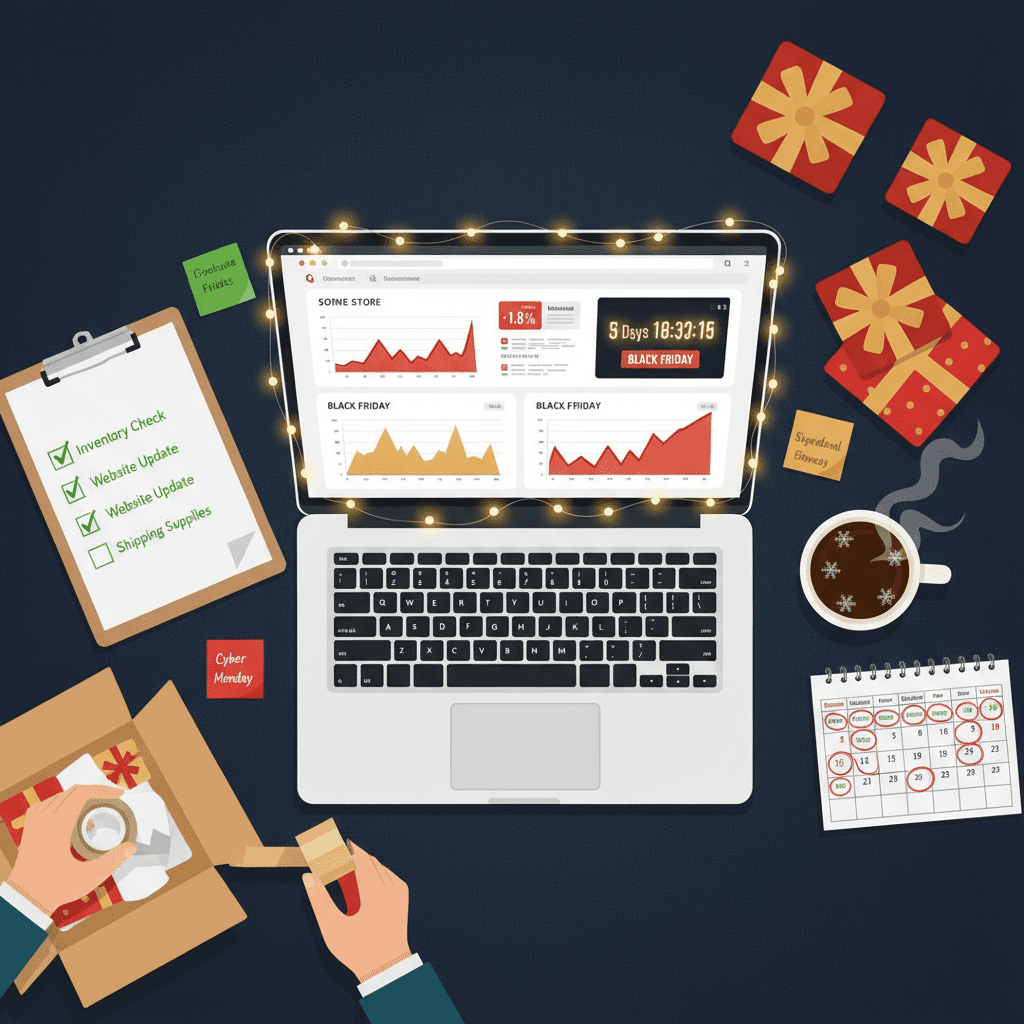Every year, I meet merchants who tell me they’ll “get around to” planning for Black Friday once the leaves turn. My honest response? If you’re only starting when the pumpkins come out, you’re already late.
The ideal time to prepare is before the end of summer. Retail calendars don’t run on warm July dreams—they run on cold November realities. That said, if you haven’t started yet, don’t panic. Smaller operations in particular can still move quickly enough to put smart plans in place. With some focused effort and the right priorities, you’ll still be able to hit the season running instead of stumbling.
The key is to focus on the fundamentals. Over the last three decades, I’ve lived through chaotic, sleepless Decembers and also through calm, smooth ones. The difference always came down to preparation. Below, I’ve laid out the ten most important steps to make sure you’re not scrambling when the holiday rush hits.
1. Get Your Promotions Planned Early
Scrambling to invent offers on the eve of Black Friday is the fastest way to chaos. Last‑minute promotions create unnecessary pressure on marketing, design, and operations. They also tend to be poorly connected—discounts that overlap, offers that confuse customers, and campaigns that strain your profit margins.
Early planning ensures you can:
- Coordinate promos with inventory so stock doesn’t vanish in three hours.
- Give your creative and marketing teams time to build assets and schedule campaigns properly.
- Test landing pages, emails, and checkout flows in advance rather than discovering broken links at 1:00 am
Think of it this way – promotion planning is like setting up holiday lights. If you do it calmly in October, you might even enjoy it. If you’re untangling knotted wires at midnight during a snowstorm, you’ll regret your choices.
2. Automate Where Possible (Unless You Like Midnight Shifts)
Let me tell you about one holiday season when we ran a “25 Days of Giving” campaign—different promotions every single day of December. At that time, our e‑commerce platform didn’t allow scheduled changeouts.
That meant every night at midnight, I had to log in, swap out the promo, test it, and check that nothing had broken. It took one to two hours. Every. Single. Day.
By week two, I was exhausted. I started making small errors – wrong promo codes, missing banners, broken checkout flows. It wasn’t fair to the team or the customers—and it certainly wasn’t sustainable.
The lesson? Well, there’s two.
First, if your platform supports automation, use it. Scheduled promotions, automated price changes, and pre‑loaded creative assets save your sanity and reduce errors. If your system doesn’t support these, consider temporary workarounds (like scheduling through third‑party apps).
And second, keep your promos simple. All those promos worked to our detriment. They were confusing to our customers, caused mistakes, didn’t give us time to warm up our ad campaigns, and worst of all, cost me a lot of sleep.
3. Prepare Your Distribution Team
Marketing often gets the attention before Black Friday. Operations—picking, packing, and shipping—is what makes or breaks the season. It’s one thing to drive orders; it’s quite another to get them out the door correctly and on time.
Practical steps:
- Capacity planning: Estimate order volume very optimistically. Then add 20%.
- Cross‑train staff: Make sure even people in finance or merchandising can spend a day packing orders if needed.
- Overflow plan: Have on‑call staff or temporary workers lined up in case the surge is bigger than expected.
A well‑oiled distribution team protects your customers from delays and protects your company from angry phone calls.
4. Line Up Backup Carriers
Here’s a scenario I’ve seen too many times – your main carrier promises “on‑time holiday delivery”—until their network clogs up under demand. Suddenly, parcels are sitting in depots, tracking updates are vague, and your customers are venting online.
To prevent this, arrange relationships with multiple carriers in advance. Even if you don’t plan to use them initially, set up the paperwork, rate cards, and integration ahead of time. That way, if your primary carrier falters, you can flip the switch quickly instead of scrambling mid‑December.
5. Keep Customer Service in the Loop
Customer Service (CS) teams are your frontline. If they’re unprepared, the holiday surge will overwhelm them—and your customers will feel it.
Practical preparation:
- Talking points: Draft clear scripts or notes so reps know exactly how to respond when shipping delays, promo issues, or stock shortages arise.
- Proactive messaging: Post banners or notices on your site if you’re experiencing delays. Better to own the message early than have customers find out later.
- Internal communication: Loop CS into daily updates. If fulfilment is behind by two days, they need to know immediately.
A well‑prepared CS team can turn a frustrated customer into a loyal one. An uninformed CS team just makes things worse.
6. Stress‑Test Your Technology
Cloud‑based platforms like Shopify Plus or Salesforce Commerce Cloud usually scale automatically. But if your stack includes custom plug‑ins, extensions, or in‑house infrastructure, you’ll want to test, because these often use external servers and infrastructure that don’t run the same sort of rigorous tests that the platforms do.
Key checks:
- Run load tests to simulate high traffic.
- Validate checkout flows—especially if you’ve added third‑party payment methods.
- Verify that inventory syncs correctly between channels (marketplaces, POS, web).
- All your apps, plug-ins, extensions, core changes, and/or custom development hold up under the strain
During one past season, I saw a retailer lose thousands in sales because a third‑party personalization app buckled under load. Customers couldn’t add items to cart. That’s not the story you want told about your brand.
7. Plan a Code Freeze
Around early November, you should lock down major changes to your site. This is called a **code freeze**.
The principle is simple – don’t introduce new risks right before the busiest shopping days of the year. If you must fix a critical bug, do it carefully, but avoid new features, design overhauls, or platform migrations.
I’ve seen teams push last‑minute “must‑have” features that ended up breaking checkout flows on Black Friday morning, costing 10s of thousands of dollars in lost sales. At that point, the shiny feature doesn’t matter—you’ve just lost revenue. Stick with tried, tested, and stable.
8. Play the Promotion Timing Game
Every year, retailers play a game of chicken – who launches their Black Friday discounts first? Customers now expect deals well before the actual Friday. If you stick to tradition while competitors move early, you risk losing sales.
The best approach: have both Plan A (traditional launch timing) and Plan B (early‑launch promotions) ready. Watch your competitors. The moment one of them blinks, you can react with your prepared campaign instead of rushing something half‑baked.
9. Decide on Your Returns Policy
Holiday returns can make or break customer loyalty. Consider extending your return window to accommodate gift purchases made in November or early December. A policy that allows January returns is now an expectation rather than a luxury.
Make sure the policy is:
- Visible on product pages and checkout.
- Understood by both CS teams and warehouse staff.
- Costed into your financial modelling. Extended returns come with a cost, but they also build trust.
10. Do the Hard Work Now, Relax Later
Here’s the irony – if your preparation is thorough, Black Friday itself can feel anticlimactic. The promos are pre‑loaded, the team is trained, the systems are stable. Your role shifts from firefighting to monitoring dashboards and celebrating milestones.
Those are the best seasons—the ones where you’re not huddled in a server room or sleeping at your desk. Instead, you’re watching sales roll in, grateful for the prep work that allowed you to breathe.
Final Thoughts
Black Friday and the holiday season aren’t just about promotions. They’re about resilience. The more you anticipate, the less you react.
I’ve lived through both sides – the years of rushing, midnight logins, and patches held together with duct tape, and the years of well‑planned calm. The latter always outperform in both sales and sanity.
So if you haven’t started yet, start today. Prioritize the fundamentals above – promos, automation, distribution, carriers, customer service, system stability, code freeze, promo timing, and returns policy. Even if you can’t perfect everything this year, every step you take now lays the foundation for smoother seasons ahead.
Black Friday will come whether you’re ready or not. The choice is yours: do you want to be exhausted and reactive, or prepared and in control?





